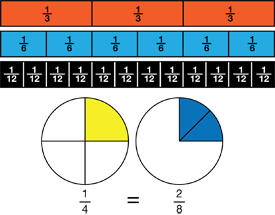Students explore comparing, ordering, and finding equivalent fractions using a variety of representations. This workshop lesson provides opportunities for students to revisit concepts in new contexts, practice skills, apply concepts, or extend their learning.
Content in this Lesson
- Finding equivalent fractions using area models [E8].
- Comparing and ordering fractions using area models and number lines [E9].
- Making connections among representations of fractions, including symbols, words, area models, and number lines [E7].
- Naming and representing fractions greater than one as mixed numbers or improper fractions [E5].
- Communicating solution strategies [MPE2, MPE5].
- Representing fraction comparisons with symbols (e.g., <, >, =) [E7].
Assessment in this Lesson
| Assessment | Expectation Assessed | Math Practice Assessed |
|---|---|---|
|
Workshop: More Than, Less Than, or Equal To |
|
|
|
Workshop: More Than, Less Than, or Equal To |
|
|
|
Ordering Fractions |
|
|
|
DPP Item KK |
|















